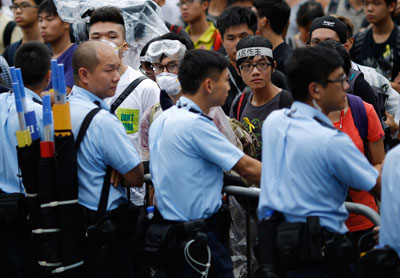We have been receiving reports of harassment and the use of force directed toward journalists covering the demonstrations in Hong Kong. Most of the incidents came over the weekend with the government’s ill-advised attempt to end the protests with police force. But with tensions building today, more clashes with police seem possible.
A reporter who has been maintaining contact with us told of several incidents of pushing and shoving in recent days, and the refusal in several instances to allow journalists to enter protest areas. The police sometimes use the excuse of a lack of media credentials as their reason to prevent access. Freelancers and journalism students seem to be their favorite targets.
Here are a few resources for journalists inexperienced in covering civil disruptions like those taking place in Hong Kong. We’ll also be sharing these on our social media handles, http://twitter.com/cpjasia and http://www.facebook.com/cpjasia.
The CPJ Journalist Security Guide is available in English and Mandarin–sorry, Hong Kong colleagues, but there’s no Cantonese version. The guide is worthwhile reading for Hong Kong professionals and those many citizen journalists and J-school students who are trying to document the situation on the ground. There is a particularly relevant section, Covering Civil Matters and Disturbances, that deals with protests and riots. Chapter 10 covers stress and taking care of yourself, and should be read closely, given the extended nature of the demonstrations. If you’ve take on the responsibility of recording these historic events, do it in a way that is responsible to your role as a journalist, but one that also respects your own personal needs. Personal burnout might feel heroic, but it does not guarantee responsible journalism.
Our colleagues at Witness also have an excellent series of short videos aimed at “helping activists and journalists film protests and police conduct more safely, ethically, and effectively.” They are sort of a crash course in Video Journalism 101, for anyone using a smart phone or a video camera. But even if you’ve been shooting video for a while, these are worth watching:
Filming Protests & Police Brutality
5-Part Video Series: Filming Protests
Documenting Human Rights Violations
Almost as important, Arul Prakkash, Witness’s program manager for Asia and the Pacific, tells us he is concerned that much of the footage of the demonstrations in Hong Kong is not being archived and saved in a responsible way. “What’s happening to the footage? Where is it being uploaded? How are files being kept?” he asked in an email message this morning. If you have the answers to these questions, you can reach him at prakkash@witness.org .
